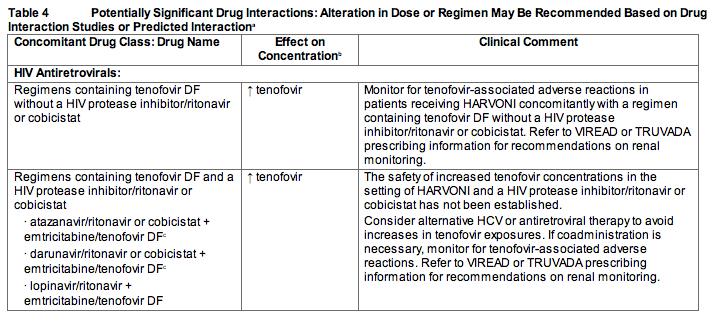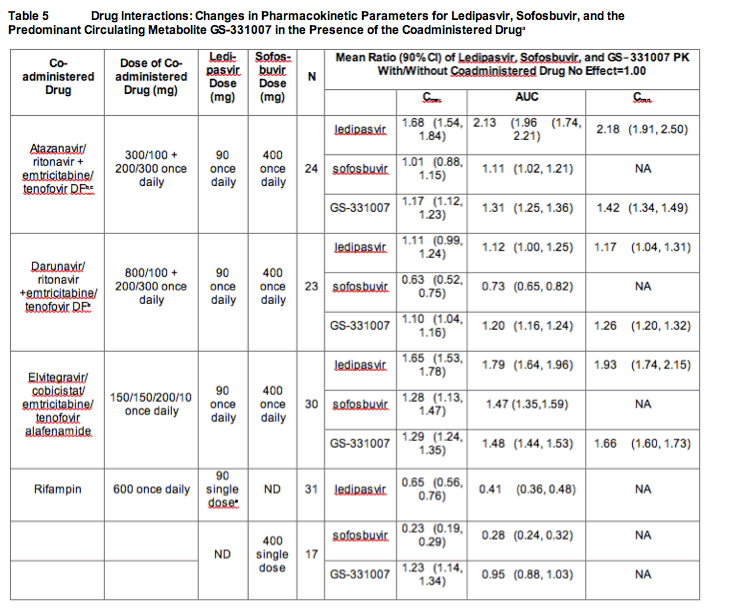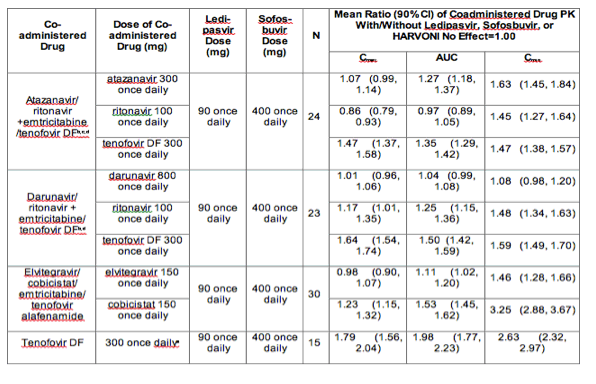| |
Harvoni FDA Label Update- HIV/GT-4/5/6 PK/DDIs
|
| |
| |
HCV USA/Prevalence 8-9 Million?? - (10/09/15)
HARVONI (ledipasvir/sofosbuvir) label updated - Approved for HIV/HCV Coinfection; Genotypes 4, 5 & 6
U.S. FDA Approves New Indications for Harvoni®, Gilead's Once-Daily Single Tablet Regimen for Chronic Hepatitis C - (11/13/15)
Harvoni GT-6 - (09/17/15)
EASL: Ledipasvir/Sofosbuvir for the Treatment of Patients With Chronic Genotype 4 or 5 HCV Infection - (04/29/15)
GT 6 & 5 SVRs Harvoni & Future Gilead Therapies (daclatasvir Gt5/6 in vitro activity) - (09/14/15)
GS-9857 in Genotypes 1-6 - (09/14/15)
Harvoni GT4/5 - EASL/2015-GS9857/GS5816 - (09/04/15)
--------------------------------------
The HARVONI (ledipasvir/sofosbuvir) labeling was updated to: (1) expand the indication to the treatment of chronic hepatitis C virus (HCV) genotype 4, 5 and 6 infection, (2) include dosage recommendations for HCV/HIV-1 co-infection and (3) state HARVONI + ribavirin for 12 weeks can be considered in treatment-experienced genotype 1 patients with cirrhosis who are eligible for ribavirin. Additionally the label was updated with drug-drug interaction information. The major changes are as follows.
INDICATIONS AND USAGE
HARVONI is indicated for the treatment of patients with chronic hepatitis C virus (HCV(CHC) genotype 1, 4, 5, or 6 infection.
DOSAGE AND ADMINISTRATION
Table 1 shows the recommended HARVONI treatment duration based on patient population.
For patients with HCV/HIV-1 co-infection, follow the dosage recommendations in Table 1

* HARVONI for 8 weeks can be considered in treatment-na夫e genotype 1 patients without cirrhosis who have pre-treatment HCV RNA less
than 6 million IU/mL [see Clinical Studies (14.2)].
**Treatment-experienced patients include those who have failed a peginterferon alfa + ribavirin based regimen with or without an HCV protease inhibitor.
HARVONI+ribavirin for 12 weeks can be considered in treatment-experienced genotype 1 patients with cirrhosis who are eligible for ribavirin [see Clinical Studies (14.2)]. The daily dosage of ribavirin is weight-based (1000 mg for patients <75 kg and 1200 mg for those ウ75 kg) administered orally in two divided doses with food. Refer to the ribavirin prescribing information.
ADVERSE REACTIONS
The safety assessment of HARVONI was also based on pooled data from three open-label trials (Study 1119, ION-4 and ELECTRON-2) in 118 subjects with chronic HCV genotype 4, 5 or 6 infection with compensated liver disease (with or without cirrhosis) [see Clinical Studies (14.3)]. The subjects received HARVONI once daily by mouth for 12 weeks. The safety profile in subjects with chronic HCV genotype 4, 5 or 6 infection with compensated liver disease was similar to that observed in subjects with chronic HCV genotype 1 infection with compensated liver disease. The most common adverse reactions occurring in at least 10% of subjects were asthenia (18%), headache (14%) and fatigue (10%).
Adverse Reactions in Subjects with Cirrhosis
The safety assessment of HARVONI with or without ribavirin was based on a randomized, double-blind and placebo-controlled trial in treatment-experienced genotype 1 subjects with compensated cirrhosis and was compared to placebo in the SIRIUS trial. Subjects were randomized to receive 24 weeks of HARVONI once daily by mouth without ribavirin or 12 weeks of placebo followed by 12 weeks of HARVONI once daily by mouth + ribavirin [see Clinical Studies (14.2)]. Table 3 presents the adverse reactions, as defined above, that occurred with at least 5% greater frequency in subjects treated with 24 weeks of HARVONI or 12 weeks of HARVONI + ribavirin, compared to those reported for 12 weeks of placebo. The majority of the adverse reactions presented in Table 3 were Grade 1 or 2 in severity.

Adverse Reactions in Subjects Co-infected with HIV-1
The safety assessment of HARVONI was based on an open-label clinical trial in 335 genotype 1 or 4 subjects with HCV/HIV-1 coinfection who were on stable antiretroviral therapy in Study ION-4 [see Clinical Studies (14.4)] . The safety profile in HCV/HIV-1 co-infected subjects was similar to that observed in HCV mono-infected subjects. The most common adverse reactions occurring in at least 10% of subjects were headache (20%) and fatigue (17%).
Less Common Adverse Reactions Reported in Clinical Trials (less than 5%): The following adverse reactions occurred in less than 5% of subjects receiving HARVONI in any one trial. These events have been included because of their seriousness or assessment of potential causal relationship.
Psychiatric disorders: depression (including in subjects with pre-existing history of psychiatric illness).
Depression (particularly in subjects with pre-existing history of psychiatric illness) occurred in subjects receiving sofosbuvir containing regimens. Suicidal ideation and suicide have occurred in less than 1% of subjects treated with sofosbuvir in combination with ribavirin or pegylated interferon/ribavirin in other clinical trials.
Laboratory Abnormalities
Bilirubin Elevations: Bilirubin elevations of greater than 1.5xULN were observed in 3%, less than 1%, and 2% of subjects treated with HARVONI for 8, 12, and 24 weeks, respectively. Bilirubin elevations of greater than 1.5xULN were observed in 3%, 11% and 3% of subjects with compensated cirrhosis treated with placebo, HARVONI + ribavirin for 12 weeks and HARVONI for 24 weeks, respectively, in the SIRIUS trial.
Lipase Elevations: Transient, asymptomatic lipase elevations of greater than 3xULN were observed in less than 1%, 2%, and 3% of subjects treated with HARVONI for 8, 12, and 24 weeks, respectively. Transient, asymptomatic lipase elevations of greater than 3x ULN were observed in 1%, 3% and 9% of subjects with compensated cirrhosis treated with placebo, HARVONI + ribavirin for 12 weeks and HARVONI for 24 weeks, respectively, in the SIRIUS trial.
Creatine Kinase: Creatine kinase was not assessed in Phase 3 trials ION-3, ION-1 or ION-2 of HARVONI. Creatine kinase was assessed in the ION-4 trial. Isolated, asymptomatic creatine kinase elevations of greater than or equal to 10xULN was observed in 1% of subjects treated with HARVONI for 12 weeks in the ION-4 trial and has also been previously reported in subjects treated with sofosbuvir in combination with ribavirin or peginterferon/ribavirin in other clinical trials.
DRUG INTERACTIONS
Table 4 was updated as follow.

USE IN SPECIFIC POPULATIONS
Pregnancy
Risk Summary
HARVONI in pregnant women. In animal reproduction studies, no evidence of adverse developmental outcomes was observed with the administration of ledipasvir or sofosbuvir [see Data]. Consider the benefits and risks of HARVONI when prescribing HARVONI to a pregnant woman. During organogenesis in the rat or rabbit, AUC exposure to ledipasvir was approximately 4- and 2-fold, respectively and the predominant circulating metabolite of sofosbuvir (GS-331007) increased during gestation from approximately 3- to 6-fold and 7- to 17-fold the exposure in humans at the recommended clinical dose, respectively.
In a pre/postnatal development study with ledipasvir or sofosbuvir, plasma exposure in neonate rats was approximately 4-fold lower than the maternal plasma for ledipasvir (post-parturition day 10), and the ratio of neonatal to maternal plasma exposure was less than 0.1 for the metabolite of sofosbuvir, GS-331007.
If HARVONI is administered with ribavirin, the combination regimen is contraindicated in pregnant women and in men whose female partners are pregnant. Refer to the ribavirin prescribing information for more information on use in pregnancy.
The background risk of major birth defects and miscarriage for the indicated population is unknown; however, the estimated background risk in the U.S. general population of major birth defects is 2-4% and of miscarriage is 15-20% of clinically recognized pregnancies.
Data
Animal Data
Ledipasvir: Ledipasvir was administered orally to pregnant rats (up to 100 mg/kg/day) and rabbits (up to 180 mg/kg/day) on gestation days 6 to 18 and 7 to 20, respectively. No effects on fetal development have been observed in rats and rabbits at the highest doses tested. In a pre/postnatal development study with ledipasvir, where rats were exposed up to 100 mg/kg/day, no significant adverse effects directly related to drug were noted in the offspring.
Sofosbuvir: Sofosbuvir was administered orally to pregnant rats (up to 500 mg/kg/day) and rabbits (up to 300 mg/kg/day) on gestation days 6 to 18 and 6 to 19, respectively. No effects on fetal development have been observed in rats and rabbits at the highest doses tested. In a pre/postnatal development study with sofosbuvir, where rats were exposed up to 500 mg/kg/day, no significant adverse effects directly related to drug were noted in the offspring.
Lactation
Risk Summary
It is not known whether HARVONI and its metabolites are present in human breast milk. When administered to lactating rats, ledipasvir was detected in the plasma of suckling rats likely due to the presence of ledipasvir in milk, without clear effects on nursing pups. The predominant circulating metabolite of sofosbuvir (GS-331007) was the primary component observed in the milk of lactating rats, without effect on nursing pups. The development and health benefits of breastfeeding should be considered along with the motherユs clinical need for HARVONI and any potential adverse effects on the breastfed infant from HARVONI or from the underlying maternal condition.
If HARVONI is administered with ribavirin, the nursing mothers information for ribavirin also applies to this combination regimen. Refer to the ribavirin prescribing information for more information on use during lactation.
CLINICAL PHARMACOLOGY
Table 5 and 6 were updated with the following drug-drug interaction information.
Table 5 Drug Interactions: Changes in Pharmacokinetic Parameters for Ledipasvir, Sofosbuvir, and the Predominant Circulating Metabolite GS-331007 in the Presence of the Coadministered Druga

1. Data generated from simultaneous dosing with HARVONI. Staggered administration (12 hours apart) of atazanavir/ritonavir + emtricitabine/tenofovir DF or darunavir/ritonavir + emtricitabine/tenofovir DF and HARVONI provided similar results.
2. The effects of atazanavir/ritonavir on ledipasvir and sofosbuvir are similar with or without the presence of emtricitabine/tenofovir DF.
3. Administered as ATRIPLA® (efavirenz, emtricitabine, tenofovir DF).
4. This study was conducted in the presence of two other

Genotype 4, 5 or 6
Phylogenetic analysis of HCV sequences from genotype 4-infected subjects in Study 1119 (N=44) and ION-4 (N=8) identified 7 HCV genotype 4 subtypes (4a, 4b, 4d, 4f, 4m, 4o and 4r). Most subjects were infected with subtype 4a (N=32; 62%) or 4d (N=11; 21%); 1 to 3 subjects were infected with each of the other genotype 4 subtypes. There were 3 subjects with subtype 4r, 2 of whom experienced virologic relapse, and both had a combination of 3 pretreatment NS5A resistance-associated polymorphisms (L28M/V+L30R+M31M).
Phylogenetic analysis of HCV sequences from genotype 5-infected subjects in Study 1119 showed almost all were subtype 5a (N=39) with one subject not having a subtype identified at screening or by analysis.
Phylogenetic analysis of HCV sequences from genotype 6-infected subjects in ELECTRON-2 identified 7 HCV genotype 6 subtypes (6a, 6e, 6l, 6m, 6p, 6q and 6r). Thirty-two percent of the subjects had subtype 6a and 24% had subtype 6e. One to three subjects were infected with the other subtypes 6l, 6m, 6p, 6q, or 6r. The one subject who did not achieve SVR12 had subtype 6l.
Although the data are limited, baseline HCV NS5A resistance-associated polymorphisms are not expected to impact the likelihood of achieving SVR when HARVONI is used as recommended to treat HCV genotype 4, 5, or 6-infected patients, based on the low virologic failure rate observed in Study 1119 and ELECTRON-2. The specific baseline polymorphisms observed in subjects with virologic failure were L28M/V, L30R, L31M and P58T for genotype 4; L31M for genotype 5; and Q24K, F28V, R30A and T58P for genotype 6.
Relapse occurred in 2 of 3 genotype 4 subjects who had baseline NS5B V321I, a polymorphism at a position associated with treatment failure to sofosbuvir and other nucleoside inhibitors; these two subjects also had baseline NS5A resistance-associated polymorphisms. For genotype 5 and 6, SVR12 was achieved in subjects who had baseline NS5B polymorphisms at positions associated with resistance to nucleoside inhibitors (N=1 with N142T in genotype 5; N=1 with M289I in genotype 5; N=15 with M289L/I in genotype 6). The sofosbuvir resistance-associated substitution S282T was not detected in the baseline NS5B sequence of any subject with genotype 4, 5 or 6 HCV in clinical trials by population or deep nucleotide sequence analysis.
NONCLINICAL TOXICOLOGY
Ledipasvir was not carcinogenic in the 6-month rasH2 transgenic mouse study. A carcinogenicity study in rats is ongoing.
DESCRIPTION OF CLINICAL STUDIES
Previously-Treated Adults with Cirrhosis - SIRIUS (Study 0121)
SIRIUS was a randomized, double-blind and placebo-controlled trial that evaluated theefficacy of HARVONI + ribavirin for 12 weeks or HARVONI without ribavirin for 24 weeks in genotype 1 HCV-infected subjects with compensated cirrhosis who failed prior therapy with a Peg-IFN + RBV regimen followed by a subsequent Peg-IFN +RBV + an HCV protease inhibitor regimen. Subjects were randomized in a 1:1 ratio to receive placebo for 12 weeks followed by HARVONI + ribavirin for 12 weeks or HARVONI for 24 weeks. Randomization was stratified by HCV genotype (1a vs 1b) and response to prior HCV therapy (never achieved HCV RNA less than LLOQ vs achieved HCV RNA less than LLOQ).
Demographics and baseline characteristics were balanced across the treatment groups. Of the 155 randomized subjects, the median age was 56 years (range: 23 to 77); 74% of the subjects were male; 97% were White; mean body mass index was 27 kg/m2 (range: 19 to 47 kg/m2); 63% had genotype 1a HCV infection; 94% had non-C/C IL28B alleles (CT or TT). One subject discontinued therapy while on placebo, and was not included in the efficacy analysis.
The SVR12 was 96% (74/77) and 97% (75/77) in subjects treated with HARVONI + ribavirin for 12 weeks and HARVONI for 24 weeks without ribavirin, respectively. All 5 subjects who did not achieve SVR12 relapsed.
Clinical Trials in Subjects with Genotype 4, 5, or 6 HCV
Below are trial descriptions, SVR12 and relapse data in the genotype 4, 5, and 6 HCV populations. Trial results in the genotype 4, 5, and 6 HCV populations are based upon limited number of subjects in some subgroups, particularly in subjects who have been previously-treated and subjects with cirrhosis.
Genotype 4
In two open-label studies (Study 1119 and ION-4), HARVONI was administered for 12 weeks to treatment-na夫e and previously-treated subjects with genotype 4 HCV infection. Study 1119 enrolled 44 treatment-na夫e or previously-treated subjects with genotype 4 HCV, with or without cirrhosis. ION-4 enrolled 4 treatment-na夫e and 4 previously-treated subjects with genotype 4 HCV infection who were coinfected with HIV-1, none of whom had cirrhosis.
In Study 1119, the overall SVR12 rate was 93% (41/44). SVR12 was similar based upon prior HCV treatment history and cirrhosis status. In ION-4, all 8 subjects achieved SVR12.
Genotype 5
In the open-label 1119 trial, HARVONI was administered for 12 weeks to 41 treatment-naive or previously-treated subjects with genotype 5 HCV infection, with or without cirrhosis. The overall SVR12 was 93% (38/41). SVR12 was similar based upon prior HCV treatment history and cirrhosis status.
Genotype 6
In the open-label ELECTRON-2 trial, HARVONI was administered for 12 weeks to 25 treatment-naive or previously-treated subjects with genotype 6 HCV infection, with or without cirrhosis. The overall SVR12 was 96% (24/25). SVR12 was similar based upon prior HCV treatment history and cirrhosis status. The single subject who relapsed discontinued study treatment early (at approximately Week 8).
Clinical Trials in Subjects Co-infected with HCV and HIV-1
ION-4 was an open-label clinical trial that evaluated the safety and efficacy of 12 weeks of treatment with HARVONI without ribavirin in HCV treatment-na夫e and previously-treated subjects with genotype 1 or 4 HCV infection who were co-infected with HIV-1. Treatment-experienced subjects had failed prior treatment with Peg-IFN + RBV, Peg-IFN + RBV + an HCV protease inhibitor or sofosbuvir+RBV. Subjects were on a stable HIV-1 antiretroviral therapy that included emtricitabine + tenofovir disoproxil fumarate, administered with efavirenz, rilpivirine or raltegravir.
Of the 335 treated subjects, the median age was 52 years (range: 26 to 72); 82% of the subjects were male; 61% were White; 34% were Black; mean body mass index was 27 kg/m2 (range: 18 to 66 kg/m2); 75% had genotype 1a HCV infection; 2% had genotype 4 infection; 76% had non-C/C IL28B alleles (CT or TT); and 20% had compensated cirrhosis. Fifty-five percent (55%) of the subjects were treatment-experienced.

1. The denominator for relapse is the number of subjects with HCV RNA < LLOQ at their last on-treatment assessment.
2. Other includes subjects who did not achieve SVR12 and did not meet virologic failure criteria (e.g., lost to follow-up).
SVR12 rates were 94% (63/67) in subjects with cirrhosis and 98% (46/47) in subjects who were previously-treated and had cirrhosis. The relapse rate in the ION-4 trial in Black subjects was 9% (10/115), all of whom were IL28B non-CC genotype, and none in non-Black subjects (0/220). In the ION-1, ION-2, and ION-3 HCV mono-infection studies, relapse rates were 3% (10/305) in Black subjects and 2% (26/1637) in non-Black subjects.
No subject had HIV-1 rebound during the study. The percentage of CD4+ cells did not change during treatment. Median CD4+ cell count increase of 29 cells/mm3 was observed at the end of treatment with HARVONI for 12 weeks.
You will be able to view the complete label at drugs@fda or dailymed.
Richard Klein
Office of Health and Constituent Affairs
Food and Drug
Administration
Kimberly Struble
Division of Antiviral Products
Food and Drug Administration
Steve Morin
Office of Health and Constituent Affairs
Food and Drug Administration
|
|
| |
| |
|
|
|